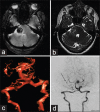Microsurgical management of aneurysms of the superior cerebellar artery - lessons learnt: An experience of 14 consecutive cases and review of the literature
- PMID: 25767580
- PMCID: PMC4352632
- DOI: 10.4103/1793-5482.151513
Microsurgical management of aneurysms of the superior cerebellar artery - lessons learnt: An experience of 14 consecutive cases and review of the literature
Abstract
Objective: This is a retrospective study from January 2002 to December 2012 analyzing the results of microsurgical clipping for aneurysms arising from the superior cerebellar artery (SCA).
Materials and methods: All patients with SCA were evaluated with computerized tomography angiography and/or digital subtraction angiography (DSA) prior to surgery. All patients in our series underwent microsurgical clipping and postoperative DSA to assess the extent of aneurysm occlusion. The Glasgow outcome scale (GOS) and the modified Rankin's scale (mRS) were used to grade their postoperative neurological status at discharge and 6 months, respectively.
Results: Fourteen patients had SCA aneurysms (ruptured-9, unruptured-5). There were 10 females and 4 males with the mean age of 47.2 years (median - 46 years, range = 24-66 years). Subarachnoid hemorrhage (SAH) was seen in 11 patients. The mean duration of symptoms was 2.5 days (range = 1-7 days). The WFNS score at presentation was as follows: Grade 1 in 10 cases, II in 2 cases, III in 1 case and IV in 1 case. In the 9 cases with ruptured SCA aneurysm, average size of the ruptured aneurysms was 7.3 mm (range = 2.5-27 mm, median = 4.9 mm). The subtemporal approach was used in the first 7 cases. The extradural temporopolar (EDTP) approach was used in the last 5 cases. Complications include vasospasm (n = 6), third nerve palsy (n = 5) and hydrocephalus (n = 3). Two patients died following surgery. At mean follow-up 33.8 months (median - 25 months, range = 19-96 months), no patient had a rebleed. At discharge 9 (64%), had a GOS of 4 or 5 and 3 (21%) had a GOS of 3. At 6 months follow-up, 10/14 (71%) patients had mRS of 0-2, and 2 (14%) had mRS of 5.
Conclusions: Aneurysms of the SCA are uncommon and tend to rupture even when the aneurysm size is small (<7 mm). They commonly present with SAH. The EDTP approach avoids complication caused by temporal lobe retraction and injury to the vein of Labbe.
Keywords: Accessory superior cerebellar artery; aneurysm; extradural temporopolar approach; subarachnoid hemorrhage; superior cerebellar artery.
Conflict of interest statement
Figures






Similar articles
-
Clinical characteristics and long-term outcomes in patients with ruptured posterior inferior cerebellar artery aneurysms: a comparative analysis.J Neurosurg. 2015 Aug;123(2):441-5. doi: 10.3171/2014.10.JNS141079. Epub 2015 Apr 17. J Neurosurg. 2015. PMID: 25884260
-
Techniques and long-term outcomes of cotton-clipping and cotton-augmentation strategies for management of cerebral aneurysms.J Neurosurg. 2016 Sep;125(3):720-9. doi: 10.3171/2015.7.JNS151165. Epub 2016 Jan 15. J Neurosurg. 2016. PMID: 26771857
-
Flow diverter devices in ruptured intracranial aneurysms: a single-center experience.J Neurosurg. 2018 Apr;128(4):1037-1043. doi: 10.3171/2016.11.JNS161937. Epub 2017 Apr 7. J Neurosurg. 2018. PMID: 28387623
-
Ruptured Distal Posterior Inferior Cerebellar Artery (PICA) Aneurysms Associated with Cerebellar Arterial Venous Malformations (AVMs): A Case Series and Review of the Literature Demonstrating the Need for Angiographic Evaluation and Feasibility of Endovascular Treatment.World Neurosurg. 2017 Jan;97:751.e7-751.e13. doi: 10.1016/j.wneu.2016.10.081. Epub 2016 Oct 25. World Neurosurg. 2017. PMID: 27793767 Review.
-
Complex intracranial aneurysms: combined operative and endovascular approaches.Neurosurgery. 1998 Dec;43(6):1304-12; discussion 1312-3. doi: 10.1097/00006123-199812000-00020. Neurosurgery. 1998. PMID: 9848843 Review.
Cited by
-
Endoscopic Endonasal Transclival Approach versus Dual Transorbital Port Technique for Clip Application to the Posterior Circulation: A Cadaveric Anatomical and Cerebral Circulation Simulation Study.J Neurol Surg B Skull Base. 2017 Jun;78(3):235-244. doi: 10.1055/s-0036-1597278. Epub 2016 Dec 22. J Neurol Surg B Skull Base. 2017. PMID: 28593110 Free PMC article.
-
Dissecting and fusiform aneurysms of the superior cerebellar artery: anatomy, clinical presentation, and treatment outcomes.Neurosurg Rev. 2024 Aug 31;47(1):516. doi: 10.1007/s10143-024-02734-0. Neurosurg Rev. 2024. PMID: 39214870 Review.
-
Role of microsurgery for treatment of posterior circulation aneurysms in the endovascular era.J Cerebrovasc Endovasc Neurosurg. 2020 Sep;22(3):141-155. doi: 10.7461/jcen.2020.22.3.141. Epub 2020 Sep 21. J Cerebrovasc Endovasc Neurosurg. 2020. PMID: 32971573 Free PMC article.
References
LinkOut - more resources
Full Text Sources
Other Literature Sources

